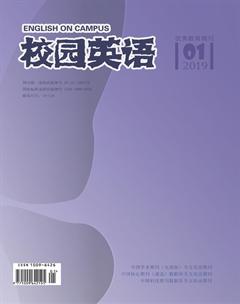浅析王佐良译作《谈读书》
翁海频 王燕
【摘要】论读书是英国文艺复兴时期散文家、哲学家弗朗西斯·培根的作品,于1653年发表,并收录于《培根随笔》中。作者旨在对王佐良译本进行分析,首先从翻译方法与技巧入手,再对翻译特点进行总结,以此剖析王佐良先生译本的独到之处。
【关键词】论读书;王佐良;翻译方法与技巧;翻译风格
【Abstract】Of study is an important article included in a book entitled “Bacons essay, published in 1653 by Francis Bacon, a British writer. This present paper aims to make analysis of the articles Chinese translation by Wang Zuoliang in terms of translation method and technique as well as its translation characteristics in order to decompose its uniqueness.
【Key words】Of study; Wang Zuoliang; translation method and technique; translation characteristics
【作者简介】翁海频,王燕(通讯作者),重庆医科大学外国语学院。
一、引言
论读书是英国文艺复兴时期散文家、哲学家弗朗西斯·培根的作品,于1653年发表,并收录于《培根随笔》中。《培根随笔》是英国随笔文学的开山之作,以其简洁的语言、优美的文笔、透彻的说理、迭出的警句,在世界文学史上占据了非常重要的地位。
全文 503 字,却涵义深广,富有哲理。文中多处采用排比或对偶,也有很多格言式的句子,给翻译增加了难度。(龚家慧,2016)
《论读书》一文是培根散文的代表作,是论述学习、教育的语篇。在词汇方面,培根使用了许多古英语及拉丁语,如“makths”、“doth not”、“Nay”、“Abeunt studia in mores”等等,同时作者为了展现平衡之美,使用了平行并列结构,即由两个意义相近或相关的词汇,用“and”,“but”“nor”等词汇手段连接,组成平行并列结构,如:“to find talk and discourse”;“be chewed and digested”;“with diligence and attention”等。名言警句的引用是《论读书》的又一特点。名言警句是人生经验和规律的总结,具有教育意义,能够起到鼓励人激励人警示人的作用,并使文章说理更加充分有说服力。在句法方面,原文简单句、并列复合句以及排比句相间交替使用,使得文章结构层次清晰,说理气势充沛。此外,文中较少使用人称代词,以增强文章的客观性及正式性。这些词汇及句法特征体现了文章正式、庄重、典雅的文体特点。在修辞方面,文中大量使用排比句。用排比来说理,可以收到条理分明的效果;增强语言的气势和韵律美。同时文中还相间使用比喻的修辞手段,可使说理生动形象具体可感,以此引发读者联想和想象,给人以鲜明深刻的印象,并使语言文采斐然,富有很强的感染力。总之,培根的这篇散文语言简洁,文笔优美,警句迭出,在世界文学史上占据了非常重要的地位。
二、翻译风格
《谈读书》译本众多,王佐良先生以半文半白的文体,精湛地译出培根散文简约的风格,译出培根自信的口吻,古色古香的文字中,饱含着人生的经验和智慧。
王佐良先生一生著作、译作丰富。一方面,他对文学研究抱有罕见的热情。“他的著作既令人高山仰止,又親切动人。”(李赋宁 1996: 4)王佐良在外国文学研究上最重要的学术贡献在于对英国文学史(包括诗史、散文史、小说史、戏剧史等)的研究和撰著。著有The Literary Reputation of John Webster, Degrees of Affinity: Studies in Comparative Literature, 《英国文学论文集》,《英语文体学论文集》,《照澜集》,《风格和风格的背后》等。另一方面,王佐良利用有限的时间从事翻译研究与实践,并自谦为“一个业余翻译者”。他的译作有《彭斯诗选》,《苏格兰诗选》,《英国诗文选译集》,Thunderstorm(曹禺《雷雨》英译)等。
王佐良先生《谈读书》的译本体现了功能对等的特点。
“动态对等”翻译是奈达的最主要的翻译观。他认为,对等可以分为两种,形式对等和动态对等 。(Nida,Eugene A.Toward a science of translating,1964)因此,我们可以得知,动态对等也就是两种语言之间不仅应该是意义的对等,而且还是文体风格和语言特点的对等,以及还要使译文给读者心灵上的反响与原文对读者内心所激发的情感对等。奈达与德瓦尔( De War) 合著的《从一种语言到另一种语言:论圣经翻译中的功能对等》一书中把“动态对等”改为“功能对等”( Functional Equivalence) 。而功能对等更突显出的是翻译的语用与交际功能 。(Nida,Eugene A &C; R Taber. The theory and practice of translation,1969)奈达定义的原文是: Translating consists in re-producing in the receptor language the closest natural equivalent of the source - language message,first in terms of meaning and secondly in terms of style. 这个定义的正确译文应是: 翻译是首先在意义上,其次在风格上用接收语再现源语信息最接近的、自然的对应信息( 或相当信息) 。
从“动态对等论”看,王佐良先生《论读书》的译文在词汇、句法、修辞及行文风格等诸方面都做到了对等。
1.词汇对等。
原文:for delight,for ornament,and for ability
译文:怡情,傅彩,长才
原文:a full man; a ready man; an exact man.
译文:充实、机智、准确。
原文:Histories,poems,mathematics,natural philosophy,moral,logic and rhetoric
译文:读史,读诗,数学,科学,伦理学,逻辑修辞之学。
原文:Bowling,shooting,gentle walking,riding
译文:滚球,射箭,漫步,骑术。
2.句法对等。
原文:Studies serve for delight, for ornament, and for ability.
译文:读书足以怡情,足以傅彩,足以长才。
原文:Their chief use for delight, is in privateness and retiring; for ornament, is in discourse; and for ability, is in the judgment, and disposition of business.
譯文:其怡情也,最见于独处幽居之时;其傅彩也,最见于高谈阔论之中;其长才也,最见于处世判事之际。
原文:To spend too much time in studies is sloth; to use them too much for ornament, is affection; to make judgment wholly by their rules, is the humour of a scholar.
译文:读书费时过多易惰,文采藻饰太盛则矫,全凭条文断事乃学究故态。
原文:Crafty men contemn studies, simply men admire them, and wise men use them;
译文:有一技之长者鄙读书,无知者羡读书,唯明智之士用读书。
原文:Read not to contradict and confute; nor to believe and take for granted; nor to find talk and swallowed, but to weigh and consider.
译文:读书时不可存心诘难作者,不可尽信书上所言,亦不可寻章摘句,而应推敲细思。
原文:Some books are to be tasted,others to be swallowed, and some few to be chewed and digested; that is, some books are to be read only in parts; others to be read, but not curiously; and some few to be read wholly, and with diligence and attention.
译文:书有可浅尝者,有可吞食者,少数则需咀嚼消化。换言之,有只须读其部分者,有只须大体涉猎者,少数则须全读,读时须全神贯注,孜孜不倦。
原文:Bowling is good for the stone and reins; shooting for the lungs and breast; gentle walking fro the stomach; riding for the head; and the like.
译文:滚球利睾肾,射箭利胸肺,漫步利肠胃,骑术利头脑,诸如此类。
原文:So if a mans wit be wandering, let him study the mathematics; for in demonstrations, if his wit be called away never so little, he must begin again. If his wit be not apt to distinguish or find differences, let him study the schoolmen; for they are crymini sectores: if he be not apt to beat over matters, and to call up one thing to prove and illustrate another, let him study the lawyers cases.
译文:如智力不集中,可令读数学,盖演算须全神贯注,稍有分散即须重演;如不能辨异,可令读经院哲学,盖此辈皆吹毛求疵之人;如不善求同,不善以一物阐证另一物,可令读律师之案卷。
运用排比说理,可将道理说得充分透彻。因此,运用排比说理有很强的说服力,能够增强文章表达效果与气势,深化中心。而王佐良先生的译文,与培根原文风格吻合,体现了奈达翻译“功能对等”原则。
原文: else distilled books are like common distilled waters, flashy things.
译文: 否则书经提炼犹如水经蒸馏,味同嚼蜡矣。
原文: Some books are to be tasted,others to be swallowed, and some few to be chewed and digested; that is , some books are to be read only in parts; others to be read, but not curiously; and some few to be read wholly, and with diligence and attention.
译文: 书有可浅尝者,有可吞食者,少数则需咀嚼消化。换言之,有只须读其部分者,有只须大体涉猎者,少数则须全读,读时须全神贯注,孜孜不倦。
原文: Nay, there is no stand or impediment in the wit, but may be wrought out by fit studies; like as diseases of the body, may have appropriate exercises.
译文: 人之才智但有滞碍,无不可读适当之书使之顺畅,一如身体百病,皆可借相宜之运动除之。
用比喻来对某某事物的特征进行描绘和渲染,可使事物生动形象具体可感,以此引发读者联想和想象,给人以鲜明深刻的印象,并使语言文采斐然,富有很强的感染力。此外,比喻还可以使深刻抽象的道理浅显、具体地表达出来。王佐良先生的译本,与培根的风格吻合,体现了奈达翻译“功能对等”原则。
三、翻译方法与技巧
为了达到动态对等,王佐良先生的译本采用了转性译法、增词译法、省词译法、转态译法等翻译方法。
1.转性译法。转性译法是翻译中常用的翻译方法。所谓转性译法,即在翻译过程中,根据译文语言习惯,进行词性转换,例如:把原文中的名词转换成动词,把原文中的副词转换成介词,等等。(冯庆华,2010,p66) 例如:“Studies serve for delight, for ornament, and for ability.”(名词-动词),“ 读书足以怡情,足以傅彩,足以长才。”王佐良先生将名词: delight, ornament, ability 分别译为动词结构“怡情, 傅彩, 长才”。 “Their chief use for delight, is in privateness and retiring;for ornament, is in discourse; and for ability, is in the judgment and disposition of business.”(名词-动词),“其怡情也,最见于独处幽居之时;其傅彩也,最见于高谈阔论之中;其长才也,最见于处世判事之际。”王佐良先生将名词 privateness and retiring, discourse, the judgment,and disposition of business 分別译为动词“独处幽居、高谈阔论、处世判事”。“So if a man's wit be wandering”,(动词-形容词)“如智力不集中”。王佐良先生将动词wander译为形容词“(不)集中”
2.增词译法。所谓增词译法,即在原文基础上,添加必要单词、词组、分句或完整句,从而使译文在语法、语言形式上符合译文习惯和在文化背景、词语联想方面与原文一致,使译文与原文在内容、形式和精神等三方面都对等起来。(冯庆华,2010,p58) 例如:“For expert men can execute, and perhaps judge of particulars, one by one; but the general counsels, and the plots and marshalling of affairs come best from those that are learned.” “练达之士虽能分别处理细事或一一判别枝节,然纵观统筹、全局策划,则舍好学深思者莫属。”王佐良先生在翻译中添加“分别”、“舍......莫属”,使译文语言形式上符合汉语习惯并符合原文古朴典雅之风格。“Read not to contradict and confute;” “读书时不可存心诘难读者;”王佐良先生为“contradict and confute”增加宾语“作者”,使原本易于产生歧义的句子,意义清晰明确。“Their chief use for delight, is in privateness and retiring;for ornament, is in discourse; and for ability, is in the judgment and disposition of business.”“其怡情也,最见于独处幽居之时;其傅彩也,最见于高谈阔论之中;其长才也,最见于处世判事之际。”王佐良先生在翻译中添加“之时”“之中”“之际”,以示强调。“for natural abilities are like natural plants, that need proyning (pruning) by study;”“盖天生才干犹如自然花草,读书然后知如何修剪移接,”王佐良先生在翻译中添加原文中虽无形式但意在其中的“然后”,使译文衔接流畅。
3.省词译法。所谓省词译法,即把原文中需要而译文中不需要的单词、词组等在翻译中省略。这种省词译法一般是出于译文语法和习惯表达法需要。从一定的意义上来讲,增词译法中的规律反过来就是省词译法的规律。(冯庆华,2010,p61)例如:“And therefore, if a man write little, he had need have a great memory; if he confer little, he had need have a present wit;and if he read little, he had need have much cunning, to seem to know, that he doth not.”“因此不常作笔记者须记忆特强,不常讨论者须天生聪颖,不常读书者须欺世有术,始能无知而显有知。”王佐良先生在译文中省略连词if,使译文更简练,更符合汉语表达习惯。“They perfect nature, and are perfected by experience:”“读书补天然之不足,(而)经验又补读书之不足,”王佐良先生在译文中省略连词and,符合汉语语法和表达习惯。 “Nay there is no stand or impediment in the wit, but may be wrought out by fit studies:”“人之才智但有滞碍,(但)无不可读适当之书使之顺畅,”王佐良先生在译文中省略连词but,符合汉语语言习惯以及原文简练之风格。
4.转态译法。所谓转态译法,即在翻译过程中把原文中的被动语态转换为译文中的主动语态,或把原文中的主动语态转换为译文中的被动语态。一般来说,无论是书面语中,还是口语中,英语比汉语用更多的被动语态。英语中那些被动语态在翻译成汉语时,我们可以根据汉语语言习惯把被动语态转换为主动语态。(冯庆华,2010,p98)例如,“Some books are to be tasted, others to be swallowed, and some few to be chewed and digested; that is, some books are to be read only in parts; others to be read, but not curiously; and some few to be read wholly, and with diligence and attention.”“书有可浅尝者,有可吞食者,少数则须咀嚼消化。换言之,有只须读其部分者,有只须大体涉猎者,少数则须全读,读时须全神贯注,孜孜不倦。”王佐良先生将原文中的被动转化为汉语的主动形式,使译文符合汉语表达习惯。“and studies themselves do give forth directions too much at large, except they be bounded in by experience.” “而书中所示,如不以经验范之,则又大而无当。”王佐良先生的译文用汉语的主动形式,通过“以”表达原文这种被动关系。“They perfect nature, and are perfected by experience:”“读书补天然之不足,经验又补读书之不足:”王佐良先生出于译文前后衔接的需要,把原文的被动语态译成了汉语的主动形式,使行文更加流畅。
四、结论
动态对等理论将翻译的视角由“忠实”和“通顺”引发的争论转向了两种语言之间在意义、文体风格以及语言特点的对等。采用文言风格的王先生的译本,在词汇、句法以及修辞等诸方面体现出功能对等的特点,重现了培根散文凝练优美的特色。可以说,从王佐良先生的《论读书》译本来看,王先生做到了与培根原文的“动态对等”。
參考文献:
[1]Nida,Eugene A.Toward a science of translating:with special reference to principles and procedures involved in bible translating [M].Leiden:E.J.Brill,1964.
[2]Nida,Eugene A &C; R Taber.The theory and practice of translation [M].Leiden:E.J.Brill,1969.
[3]冯庆华.实用翻译教程[M].上海外语教育出版社,2010.
[4]胡显耀,李力.高级文学翻译[J].2009.
[5]龚家慧.《论读书》的译本对比[J].2016.

